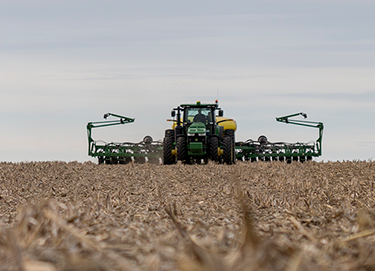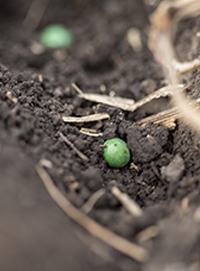It's just about time to plant your Pioneer® brand Enlist E3® soybeans. When is the optimum time to plant? And how do you position your field for favorable emergence? We’ve got a spring planting checklist to help you make the most of every acre of Enlist E3 soybeans.
Advance planning for spring planting is critical. Research has consistently shown that delays in soybean planting can cause yield to rapidly decline in the Midwest, Upper South and Deep South.
Spring soil preparation is your first priority because it will help maintain early yield potential while also setting the groundwork for a better harvest experience. But don’t overlook all the other pieces that play a role in starting the growing season right for your Enlist E3® soybeans.
1. Perform a planting equipment check
Planting success with your Enlist E3 soybeans requires well-maintained equipment that’s ready to hit the ground running when the conditions are right for planting. Take time now to inspect planting equipment and technology, make repairs, and institute upgrades. Follow these equipment prep checklists to get started.
Planter inspection
- Check the planter toolbar and parallel arms for proper alignment to prevent seed placement issues. Everyday usage can cause wobbling and misalignment. Be sure to replace bushings, bolts, and arms if you see significant wear.
- Inspect double disk openers and depth wheels. Test to make sure there is good contact between the double disks. In general, the disks must be replaced when they lose 1/2 inch in diameter. Check depth wheels for cracks and wear. Wheels should run tight against double disk openers to ensure seed furrow does not collapse. Check the depth wheel arm bushings and replace if needed.
- Inspect seed tubes and vacuum for obstructions, leaks, and loose fittings, and continue to do this regularly throughout spring planting season. Clean seed tube sensors routinely, and make sure to adjust vacuum pressure according to seed size and shape.
- Adjust coulters and row cleaners to avoid soil disturbance and creation of air pockets in seed furrows during planting.
- Consult your planter owner’s manual for make and model-specific seasonal maintenance.
General spring inspection
- Inspect fertilizer equipment for properly functioning microtubes, splitters, and pumps, and be sure to remove any old residue from last season that might clog nozzles or result in uneven application of fertilizer.
- Perform a safety and technology check on all planting equipment to make sure lights and signals work properly so you don’t risk accidents when moving from one farm or field to another and to ensure all your equipment technology is up to date.
- Check tire pressure on tractors and other field equipment to avoid compaction when planting. Generally 8 to 10 psi is ideal for most 4WD tractors, but consult the manufacturer’s recommendations. You should check and adjust tire pressure every two weeks.
- Survey field conditions. Check your farm properties for new potential equipment hazards; fences, gates or roadways that need repair; areas with potential erosion and gullies; and excessively wet areas that may indicate plugged tile lines. This is also a good time to check the weed pressure of fields.
2. Start implementing your weed control plan
- Review your weed control plan with your Enlist field specialist or Pioneer agronomist. Remember the hard and fast rule of raising row crops -- you absolutely must start clean and stay clean. Unchecked weed pressure (even slightly unchecked weed pressure) can slash yield potential. It can also build up the soil weed seed bank -- reducing the yield potential of future growing seasons. Take advantage of your field team to help you make an effective plan.
- Consider a burndown. If you didn’t apply a herbicide after fall harvest, now might be a good time to apply a burndown treatment, such as Elevore®, Enlist One® or Enlist Duo® herbicide. This is especially critical if your operation is no-till. Elevore can be applied up to 14 days before planting soybeans. For Enlist™ crops, there are no plant-back restrictions after burndown with an Enlist™ herbicide.
- Plan for preemergence applications. The recommended weed control program for Pioneer® brand Enlist E3® soybeans starts with a residual pre-emergence or burndown herbicide, with alternate modes of action where possible to help keep the weed pressure in check. Weeds are much more difficult to control post-emergence. Depending on your location, Kyber™ (Corn Belt and Plains) and Trivence® herbicides (Midsouth) are preferred residual partners with the Enlist™ system and fit very well into a program approach with Enlist One or Enlist Duo. Your field team can help you select the right modes of action for your residual applications.
3. Prepare your soil
If you want optimal growing conditions for your Enlist E3 soybeans, you’ll need optimum soil health. The health of your farmland soil depends on three critical factors: physical structure, soil composition, biological composition (ideally hosting a diverse array of microorganisms) and chemical makeup (the nutrients and minerals it contains).
Make sure your farmland is in capital shape for spring soybean planting with these spring soil preparation tips:
- Start with a soil test. Before you add any soil amendments, understand what shape your soil is in. Work with reputable soil testing facilities to collect and submit soil samples. Remember, if you collect samples on your own, get those samples to the lab as soon as possible. Most cooperative extension offices offer soil testing.
- Adjust soil pH if needed. Healthy soil generally has a pH between 6 and 7. This pH range best supports soil microbial activity that will give your spring crops the best access to nutrients. Remember, you should work with a soil testing company to determine the correct amount of lime (for low pH soils) or sulfur (for high pH soils) needed in your field.
- Consider your soil’s nutrient load. Remember: all row crops need nitrogen phosphorus and potassium. In most cases, rhizobium bacteria should be adequate enough to supply the nitrogen needs of the soybean crop. However, where fields have sat fallow/ absent of beans for extended periods of time -- it may be worthwhile to inoculate. With soybeans, potash rivals nitrogen for representation within the plant by weight. Consider an application of potash previous to planting beans -- but as always, remember that many nutrients must be supplied at just the right level, not too much and not too little.
- Take soil moisture into account and plant soybeans accordingly. Make sure you understand how moisture can impact soybean emergence and yields. Planting into soils that are too wet can cause sidewall compaction and smearing, which can restrict root development and harm yield, especially if soil dries out later in the summer. If your soil is too moist, it also can cause fungi to proliferate, potentially leading to root rot.
4. Follow best practices for planting spring Enlist E3® soybeans
When it comes to planting spring soybeans, timing is key, but it’s not everything. Before you begin spring tillage, also carefully consider seed depth, spacing, density, population and row depth. All of these factors will promote the uniform emergence that is so critical to higher soybean yields in the fall. Here are a few best practices for spring soybean planting:
- Minimize tillage if possible. As residue decreases, the moisture-conserving and erosion-preventing benefits of that residue also decrease. Conserving soil is always important, and it becomes even more imperative where top soil layers are already shallow. Always beware that every trip across the field also increases the chances of compaction-related issues.
- Plant as close to the optimum planting window as possible for your geographic location to ensure maximum yield potential. For many regions, the optimum window will be mid-April to early May, leading many agronomists to say that corn planting time and bean planting time now roll together. The research on negative impacts of late soybean planting is substantial. In the Midwest, for example, data shows that planting after May will result in a 0.7% decrease in yield per day of delay. If the conditions are right, planting in April could boost your yield. Optimum soybean growth is dependent on the shorter periods of daylight in early spring. You’ll want your soybeans flowering before the summer solstice. Check with your Pioneer agronomist for advice on your region and use this tool to see the highest yielding soybean planting dates for your state in recent years.
- Check your soil temperature. You’ll want a minimum soil temperature of 50°F.
- Consider seed treatment. If you're planting soybeans early to increase yield potential, soybean seed treatment is necessary to protect seed from prolonged exposure to soil fungi pathogens and early season insects. Treat your early planted beans with ILEVO® fungicide to reduce the risk of soybean sudden death syndrome (SDS).
- Beware of frost risk. Soybeans cannot handle the impacts of frost as well as corn can.
- Set appropriate seed depths. Always check the depth settings on your planter. And because row-to-row variability is common on planters, you should also take time to check the seed depth of every row unit across the whole planter. Check again if, once in the field, you notice changes in ground conditions.
- Plant about 5% more seeds than your target stand to account for germination failure or seedling loss. Note that this should be increased to 10% for no-till operations.
- Pay attention to seed spacing. Optimum spacing will depend on your plant population and spacing between rows. Your local Pioneer team can help you determine seed spacing with the Granular Insights app.
- Consider narrowing row spacing. Research indicates that farmers may be able to capture a 4 bu/acre yield advantage by planting in drilled narrow rows or 15-inch rows compared to 30-inch rows. The likelihood of realizing a benefit from these practices increases in lower organic soils and areas prone to drought stress. However, factors such as equipment costs, workload management and disease management may offset the potential benefits of narrower row spacing. Talk to your Pioneer agronomist about which option may be right for you.
5. Keep detailed planting records
Detailed records on Enlist E3® soybean field locations will be very important this year. Download and use the Granular Insights app to keep track of what you've planted in each field. It is beneficial to keep detailed records on field locations and share records with those responsible for weed control to ensure the right herbicides are applied to the right herbicide-tolerant traits.
Give your Pioneer® brand Enlist E3® soybeans a better chance at higher yields by following this checklist. And don’t forget to use the knowledge and resources of your local Pioneer team for even more tips and region-specific guidance.


